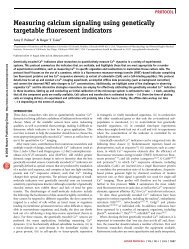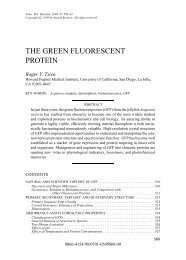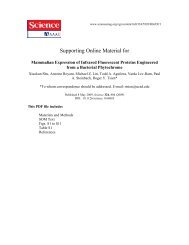Autofluorescent Proteins with Excitation in the Optical ... - Tsien
Autofluorescent Proteins with Excitation in the Optical ... - Tsien
Autofluorescent Proteins with Excitation in the Optical ... - Tsien
Create successful ePaper yourself
Turn your PDF publications into a flip-book with our unique Google optimized e-Paper software.
7 to 1.6 A˚ resolution (Figure 4). Neptune crystallized <strong>in</strong> tetragonal<br />
space group P4 22 12 <strong>with</strong> unit cell dimensions of a = b = 92.1 A˚ ,<br />
c = 53.2 A ˚ , a = b = g =90 , and <strong>with</strong> one subunit per asymmetric<br />
unit (Table 3). Symmetry operations generate a tetramer <strong>with</strong><br />
similar organization as mKate. Despite be<strong>in</strong>g characterized <strong>in</strong><br />
a different space group, <strong>the</strong> structure of Neptune is well superimposed<br />
upon <strong>the</strong> pH 7 structure of mKate (m<strong>in</strong>imum rms of 0.24 A˚<br />
over <strong>the</strong> Ca atoms of residues 1–220). Not surpris<strong>in</strong>gly, side<br />
cha<strong>in</strong>s atoms show more structural divergence from mKate than<br />
backbone atoms (m<strong>in</strong>imum rms of 0.38 A ˚ versus 0.24 A ˚ ). As <strong>in</strong><br />
mKate at pH 7.0, <strong>the</strong> chromophore of Neptune exists entirely<br />
<strong>in</strong> <strong>the</strong> cis, or Z, state, <strong>with</strong> no electron density observed <strong>in</strong> <strong>the</strong><br />
region expected for a trans-state chromophore even at a sigma<br />
value of 0.2 (Figure S5). The covalent structure of <strong>the</strong> chromophore<br />
is identical to that of dsRed, <strong>with</strong> primarily sp 2 geometry<br />
at <strong>the</strong> Ca atom of Met-63 (observed bond angles of 110 , 117 ,<br />
and 126 ), consistent <strong>with</strong> <strong>the</strong> presence of an acylim<strong>in</strong>e group.<br />
Details of <strong>the</strong> structure reveal multiple possible mechanisms<br />
for red-shift<strong>in</strong>g conferred by side cha<strong>in</strong> changes. The first is<br />
<strong>the</strong> addition of a novel hydrogen bond to <strong>the</strong> term<strong>in</strong>al oxygen<br />
of <strong>the</strong> conjugated p system of <strong>the</strong> chromophore. The cavity<br />
created by <strong>the</strong> M41G mutation <strong>in</strong> Neptune is filled by a water<br />
molecule simultaneously positioned to hydrogen bond to <strong>the</strong><br />
hydroxyl of Ser-28 (<strong>in</strong>teroxygen distance of 3.0 A˚ ) and <strong>the</strong> chromophore<br />
acylim<strong>in</strong>e oxygen (<strong>in</strong>teroxygen distance of 2.7 A˚ )<br />
(Figures 4A and 4B). Photon absorption by dsRed-like chromophores<br />
is believed to excite an electron from <strong>the</strong> highest occu-<br />
1174 Chemistry & Biology 16, 1169–1179, November 25, 2009 ª2009 Elsevier Ltd All rights reserved<br />
Chemistry & Biology<br />
Fluorescent <strong>Prote<strong>in</strong>s</strong> <strong>with</strong> Far-Red <strong>Excitation</strong><br />
Figure 4. Structural Basis for Red-Shift<strong>in</strong>g<br />
<strong>in</strong> Neptune<br />
(A) Crystal structures of mKate at pH 7 (Pletnev<br />
et al., 2008) and Neptune at pH 7 were aligned,<br />
<strong>with</strong> mKate colored p<strong>in</strong>k and Neptune light blue.<br />
The conjugated p system of <strong>the</strong> chromophore<br />
and side cha<strong>in</strong> changes <strong>in</strong>volved <strong>in</strong> red-shift<strong>in</strong>g<br />
are shown <strong>in</strong> stick representation <strong>with</strong> nitrogen <strong>in</strong><br />
blue, oxygen <strong>in</strong> red, and sulfur <strong>in</strong> yellow. Th<strong>in</strong> l<strong>in</strong>es<br />
depict o<strong>the</strong>r side cha<strong>in</strong>s.<br />
(B) Neptune conta<strong>in</strong>s an additional hydrogen bond<br />
to <strong>the</strong> chromophore. Structures of mKate and<br />
Neptune cut away to <strong>the</strong> level of <strong>the</strong> chromophore<br />
are shown. The conjugated system of <strong>the</strong> chromophore<br />
and <strong>the</strong> Met-41 side cha<strong>in</strong> are shown <strong>in</strong> stick<br />
representation colored as <strong>in</strong> (A), and <strong>the</strong> van der<br />
Waals surfaces of water oxygen atoms are depicted<br />
as dotted spheres colored p<strong>in</strong>k <strong>in</strong> mKate<br />
and light blue <strong>in</strong> Neptune. In Neptune, a water<br />
molecule occupies <strong>the</strong> space created by <strong>the</strong><br />
M41G mutation and is <strong>in</strong> hydrogen bond distance<br />
of Ser-28 and <strong>the</strong> chromophore acylim<strong>in</strong>e. Ser-28<br />
is located beneath Met-41 <strong>in</strong> mKate and is not<br />
visible.<br />
pied molecular orbital (HOMO), <strong>with</strong><br />
charge distribution concentrated over<br />
<strong>the</strong> phenolate group, <strong>in</strong>to <strong>the</strong> lowest<br />
unoccupied molecular orbital (LUMO)<br />
<strong>with</strong> a more delocalized charge distribution<br />
(Taguchi et al., 2009).<br />
Hydrogen bond donation to this term<strong>in</strong>al<br />
carbonyl oxygen of <strong>the</strong> chromophore p<br />
system would be expected to produce an absorbance red-shift<br />
by preferentially stabiliz<strong>in</strong>g <strong>the</strong> excited state and thus decreas<strong>in</strong>g<br />
<strong>the</strong> HOMO-LUMO energy difference.<br />
Ano<strong>the</strong>r possible mechanism of red-shift<strong>in</strong>g we observed <strong>in</strong><br />
Neptune is <strong>in</strong>creased coplanarity of <strong>the</strong> chromophore r<strong>in</strong>gs. In<br />
mKate, <strong>the</strong> Arg-197 and Ser-158 side cha<strong>in</strong>s extend <strong>in</strong>to a space<br />
adjacent to <strong>the</strong> chromophore (Figures 4A and 5A). In Neptune,<br />
steric clash <strong>with</strong> <strong>the</strong> larger side cha<strong>in</strong> of Cys-158 as well as <strong>the</strong><br />
Table 3. Crystallographic Data<br />
Space group P42212 Cell dimensions: a, b (A˚ ) 92.144<br />
Cell dimensions: c (A˚ ) 53.216<br />
Wavelength (eV) 11,111<br />
Resolution (A˚ ) 10.4–1.60 (1.69–1.60) a<br />
Total reflections 260,383<br />
Unique reflections 30,735<br />
Completeness (%) 99.9 (99.7) a<br />
Rsym 0.055 (0.778) a<br />
23.8 (2.2) a<br />
R/Rfree 0.171/0.202<br />
Rmsd bond lengths (A˚ ) 0.011<br />
Rmsd bond angles ( )<br />
a<br />
Highest resolution shell.<br />
1.43






